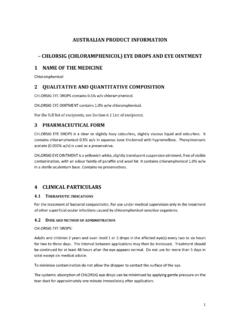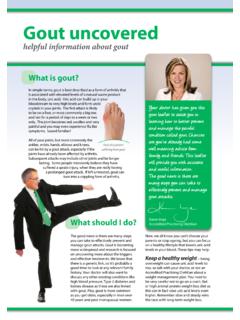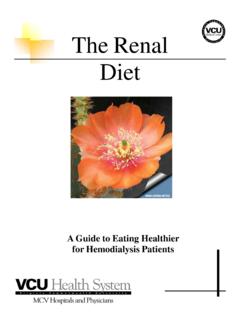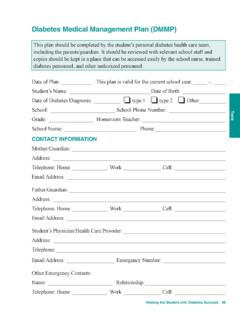Transcription of Eating well with warfarin - Aspen Pharmacare Australia
1 AEating well withwarfarinBIntroductionHave you recently started taking anti-coagulation or anti-clotting medication? Are you confused about how to eat well while on warfarin ? Or has it been a long time since you had an update on the latest dietary advice? If so, this booklet is perfect for you. In this booklet you will fi nd the latest evidence-based nutrition advice, plus important tips, tables and hints to help you get the most from your warfarin therapy. Getting started on warfarin can be a little overwhelming at fi rst, but rest assured we are here to help. Read the information on Eating well with warfarin carefully, along with any other advice on taking warfarin . Use this booklet to record your diet and then discuss any questions with your would like to acknowledge my colleagues and fellow dieticians Virginia Fazio APD and Emma Stirling APD for their professional expertise and valuable contribution to the researching and writing of this book which we hope will help you enjoy a more interesting and nutritious diet while taking Inge APD FSDAC onsultant do I need to look closely at what I eat?
2 2 Where can I find foods containing vitamin K? 3 Keeping vitamin K levels steady 4 How to follow the vitamin K exchanges system 5 The Vitamin K ready reckoner 7 Mix & match meal ideas 8 Sample meal plans 9 Food tracker diary 12 References 302 Why do I need to look closely at what I eat?It s common for medications and food to interact when taken together. While some of these interactions may be minor, it is still important to understand which foods may alter the effectiveness of your interacts with an essential nutrient in the food we eat every day, vitamin K. It is very important to plan, monitor and balance the amount of vitamin K you eat to make sure it has minimal impact on your warfarin therapy. How do you know if warfarin is working?The only way your doctor can tell if your warfarin is working safely and effectively is by a blood test called the International Normalised Ratio or INR.
3 In the early days of taking warfarin you will likely have this test every few days, then weekly or perhaps monthly as your dose is adjusted to achieve the right balance between bleeding and clotting, known as the target INR range. When you fi rst start taking warfarin , your job is to carefully plan and record what you eat and drink, particularly foods containing vitamin K and is one key rule to follow when Eating well with warfarin , according to the latest evidence-based nutrition advice: Keep your intake of vitamin K containing foods steady and , if your vitamin K intake is out of balance, your INR may be out of balance too. Through this booklet you will learn how to track and adjust your vitamin K intake. It s important to realise that reducing your intake of vitamin K foods is defi nitely not the message.
4 If you have heard this in the past, it is now outdated advice. In fact, going too low on intake of vitamin K may cause more problems with your INR balancing act, as a certain amount of vitamin K is required for steady clotting and stable control of ll fi nd a handy vitamin K ready reckoner and a food tracker diary in this booklet. Learning about dietary sources of vitamin K and a way to balance your intake is vital to ensure your warfarin works properly. If your vitamin K intake is out of balance, your INR may be out of balance too and your warfarin may not work effectively. You should always tell your doctor about changes to your health and other medications you may be taking, including herbal supplements. Based on this information your doctor may adjust your warfarin dose to fi nd the right balance for you.
5 Where can I find foods containing vitamin K?The richest dietary sources of vitamin K are dark, green leafy vegetables such as spinach, silver beet, brussels sprouts, broccoli, chinese cabbage, parsley and certain lettuces. Generally, the greener the vegetable, the higher the vitamin K the vitamin K ready reckoner on page 7 as your daily guide to the vitamin K content of common foods. We have included the serve size, amount of vitamin K and a handy exchanges system. The foods are ranked from the highest source of vitamin K (6 exchanges) to the lowest source (1 exchange). Remember, not all green fruits and vegetables are rich in vitamin K. For example, cucumber, avocado and capsicum in serves of half a cup or less are low in vitamin K. If you have a favourite dark, green plant-based food not on this list, talk to your doctor or an accredited practising dietitian to fi nd out how much vitamin K it contains.
6 DID YOU KNOW? It s a common myth that people taking warfarin should cut down on vitamin K foods. In fact, greater body stores of vitamin K allow for steady clotting and stable control of vitamin K levels steadyKeeping your vitamin K levels steady and helping your warfarin work effectively means: Enjoying a variety of food while tracking consistent vitamin K intakes. Planning your meals and snacks to ensure balanced intakes of vitamin K exchanges each day. Avoiding fasting, fad or crash diets, which cut out foods or focus on large amounts of one food, like a juicing regimen. There have been reports of changes in INR when people have consumed very large amounts of avocados, mangos, soy drink, green tea, or cranberry or grapefruit Moderating your alcohol intake within recommended limits of 1 2 standard drinks per day.
7 Alcohol can affect blood clotting when consumed in large amounts. A standard drink is 100 ml of wine, 285 ml of standard beer or 30 ml of spirits. Adjusting your set vitamin K intake from your usual pattern, in consultation with your doctor. You may like to do this if, for example, you re planning an extended holiday in Asia and will be Eating more stir-fries and dishes with Asian greens. Talking to your doctor about any digestive issues, such as constipation or diarrhoea, because a healthy gut also makes a form of vitamin K (vitamin K2 or menaquinones). Always inform your doctor or healthcare professional that you are taking warfarin , including visits to the dentist or hospital. Alerting your doctor to any other medications, vitamin or herbal supplements you are taking, including fish or krill oils, Chinese herbs, coenzyme-Q, ginkgo biloba, ginseng, turmeric, willowbark, wheatgrass, garlic or red clover.
8 Talking to your doctor about taking vitamin K supplements. If you take a multivitamin which includes vitamin K, ensure that you take it consistently every day. Avoiding large doses of vitamins A, C and E as these can affect blood clotting. In general, avoid supplements which contain more than 10,000 IU of vitamin A, 1,000 mg of vitamin C or 400 IU of vitamin to follow the vitamin K exchanges systemYou can select any number of exchanges you like to eat each day but the key issue is to be consistent. Try to eat around the same number of vitamin K exchanges every day. However, it is recommended you eat at least 200 micrograms (mcg) per day, which is approximately 4 exchanges. Why? Because people with a low daily vitamin K intake are more likely to have variations in their Talk to your doctor if you typically have a very low intake of, or dislike, these foods.
9 You may be advised to take a low level vitamin K supplement each day, 1: Work out your daily intake of vitamin K Look at the vitamin K ready reckoner table (see page 7). Highlight the foods you like. Work out the amount or number of exchanges of vitamin K you usually eat each day (minimum 200 micrograms or 4 exchanges). Step 2: Keep the number of exchanges steady and balanced Track all the foods and drinks you have each day using the food tracker diary (starts on page 14). Keep doing this until you feel confident of the amount of vitamin K in certain foods and your doctor is happy that you are achieving a steady INR. Go back to tracking if your INR levels become unstable. 6It is important to be consistent with your daily intake of vitamin K or number of exchanges.
10 Some variation is acceptable but try not to vary up or down by more than one exchange on any day. For example: if your usual intake is 200 mcg of vitamin K per day, which is equal to four exchanges, it would be acceptable to vary your exchanges by one, you could have three exchanges (150 mcg) or fi ve exchanges (250 mcg) in a day as an occasional you start to regularly eat more or less vitamin K then your doctor may need to alter your warfarin Australian Guide to Healthy Eating recommends 5 to 7 serves of vegetables per day for ,16 Count your vitamin K vegetables towards your daily tally, as well as any other favourite vegetables like pumpkin, caulifl ower, carrots and tomatoes as you desire. Remember, not all green fruit and vegetables are rich in vitamin OFFER:To assist you with monitoring your INR, check out the special offer on page K ready reckonerMake sure you use household measuring cups to calculate your serving sizes, as guessing the quantities could affect your vitamin K K (mcg)Vit.









